
Date: Mar. 21, 2025 Read: 935
Share:




Being constantly iterated, Generative AI and large language models (“LLMs”) have become the cores driving forward various applications. However, with the increasing scale and complexity, these models also pose greater challenges to storage devices.
By leveraging DeepSeek's deep thinking and networked search capabilities, we entered the question “What are the core requirements for PCIe 5.0 SSD in the context of rapid iteration of large models?” into DeepSeek. Here is its response: “The rapid iteration of large models places higher demands on storage systems. In particular, as PCIe 5.0 SSD serves as the key data carrier, it needs to make comprehensive breakthroughs in multiple dimensions such as read/write performance, latency, capacity, and reliability in order to support the real-time requirements of large model training/inference.”
Next, we’ll drill down into the excellent performance of Union Memory PCIe 5.0 ESSD UH812a/UH832a.
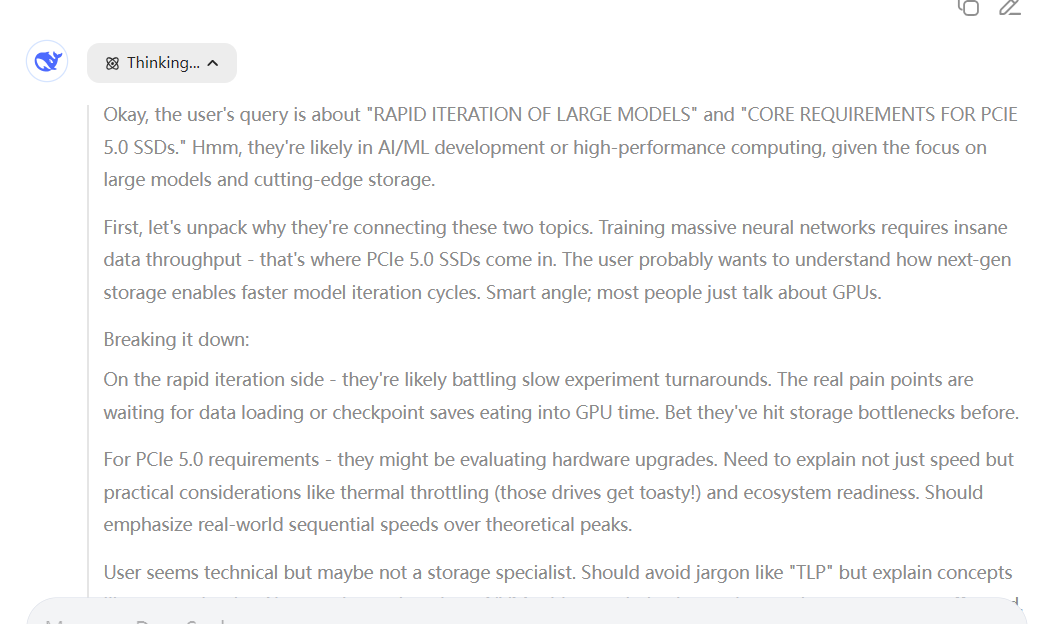
During the construction of large language models, the data collection, cleaning, training, archiving, and inference scenarios typically exhibit such characteristics as more reads and fewer writes, more sequential business operations, and fewer random business operations. If data is regarded as the core fuel, then high-performance enterprise SSDs can be called the “intelligent hub for fuel transmission”. Currently, Union Memory UH812a/UH832a, which has been evolved to the PCIe 5.0 Generation, adopts the PCIe 5.0 interface, featuring ultra-high bandwidth and low latency. It offers various single-disk capacity options ranging from 1.6TB to 15.36TB, effectively meeting the needs of different application scenarios.
Union Memory UH812a/UH832a adopts an enterprise PCIe 5.0 interface. Its data throughput efficiency is twice that of the previous generation (PCIe 4.0 SSD UH811a series). It also supports dual ports, bringing a qualitative leap in storage capabilities for such scenarios as data center model training, big data applications, cloud computing services, and network connections. Meanwhile, this interface is backwardly compatible with older versions, which not only enhances storage performance but also remarkably reduces server power consumption, helping enterprises protect their original investments and lower operating costs during device upgrades.
In sequential reading/writing, Union Memory UH812a/UH832a has a sequential read speed of 14900 MB/s, ranking TOP1 among competitors, and a sequential write speed of 10500 MB/s, which is 69% higher than that of international competitors and is at the leading level in the industry. In random reading/writing, it is also an excellent performer, with 4KB random reading IOPS at a speed of 3500K, ranking TOP1 among competitors, and random writing IOPS at a speed of 1000K, 52% higher than that of international competitors. It can easily handle such scenarios as massive order data processing on e-commerce platforms and dynamic information reading/writing on social platforms, ensuring fast data reading/writing and effectively guaranteeing the smooth operation of these platforms.
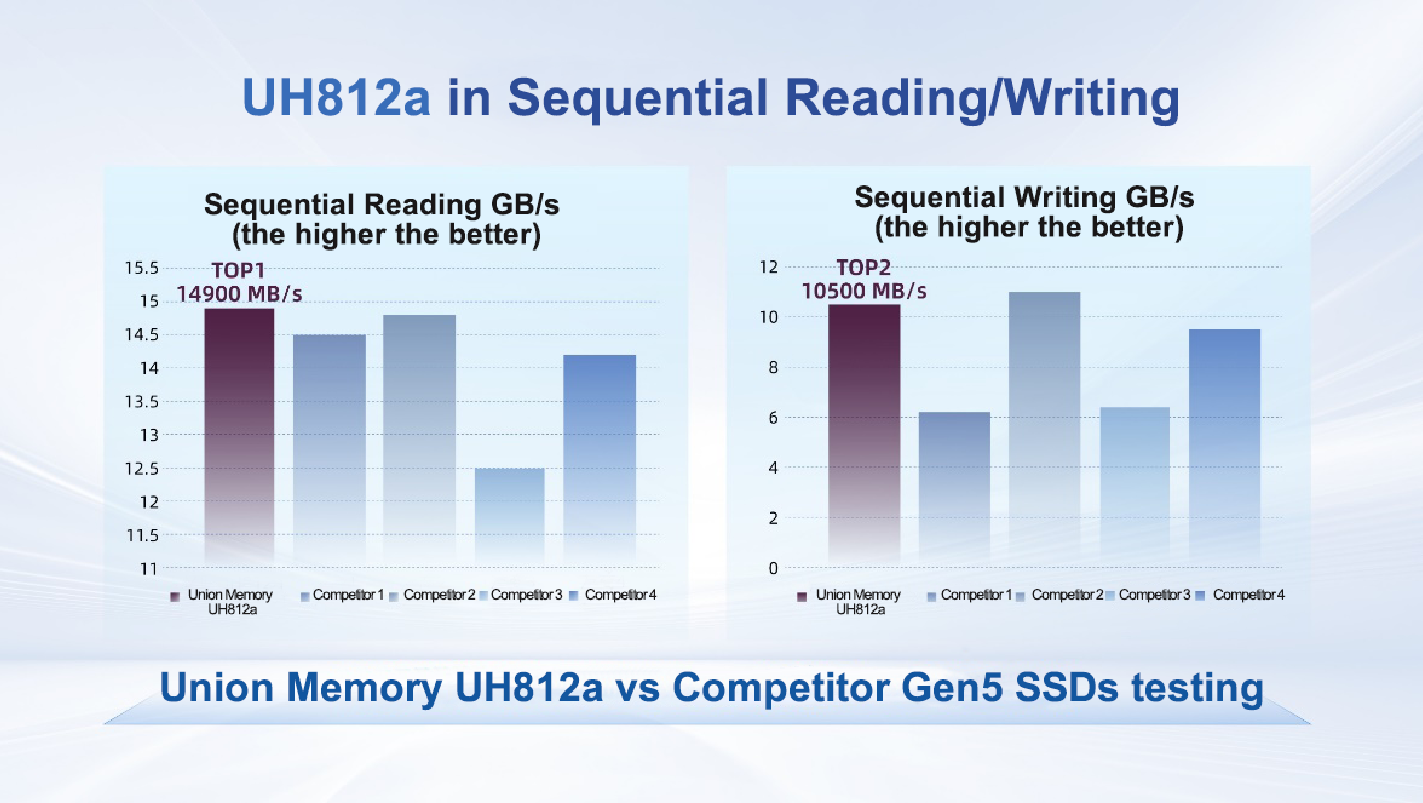
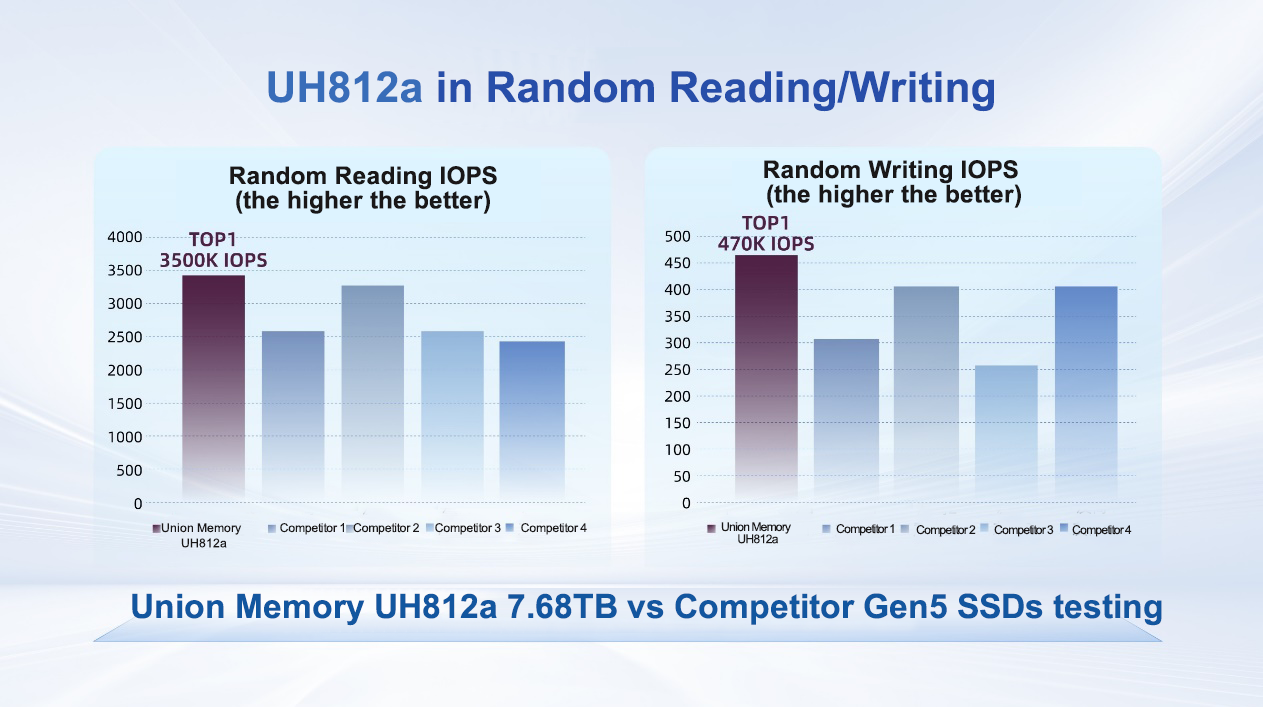
In high-performance computing environment, Union Memory UH812a/UH832a stands out for its feature of ultra-low latency. Its 4K random reading latency (QD1) is less than 55μs, which is 43% better compared to that of the previous generation (PCIe 4.0 SSD UH811a series), and its 4K random writing performance ranks TOP1 among competitors, and its random reading performance is 25% better than that of international competitors. Whether it is running complex simulation programs or processing massive data sets, it can achieve microsecond-level response, laying a solid foundation for high-performance computing and data-intensive applications.
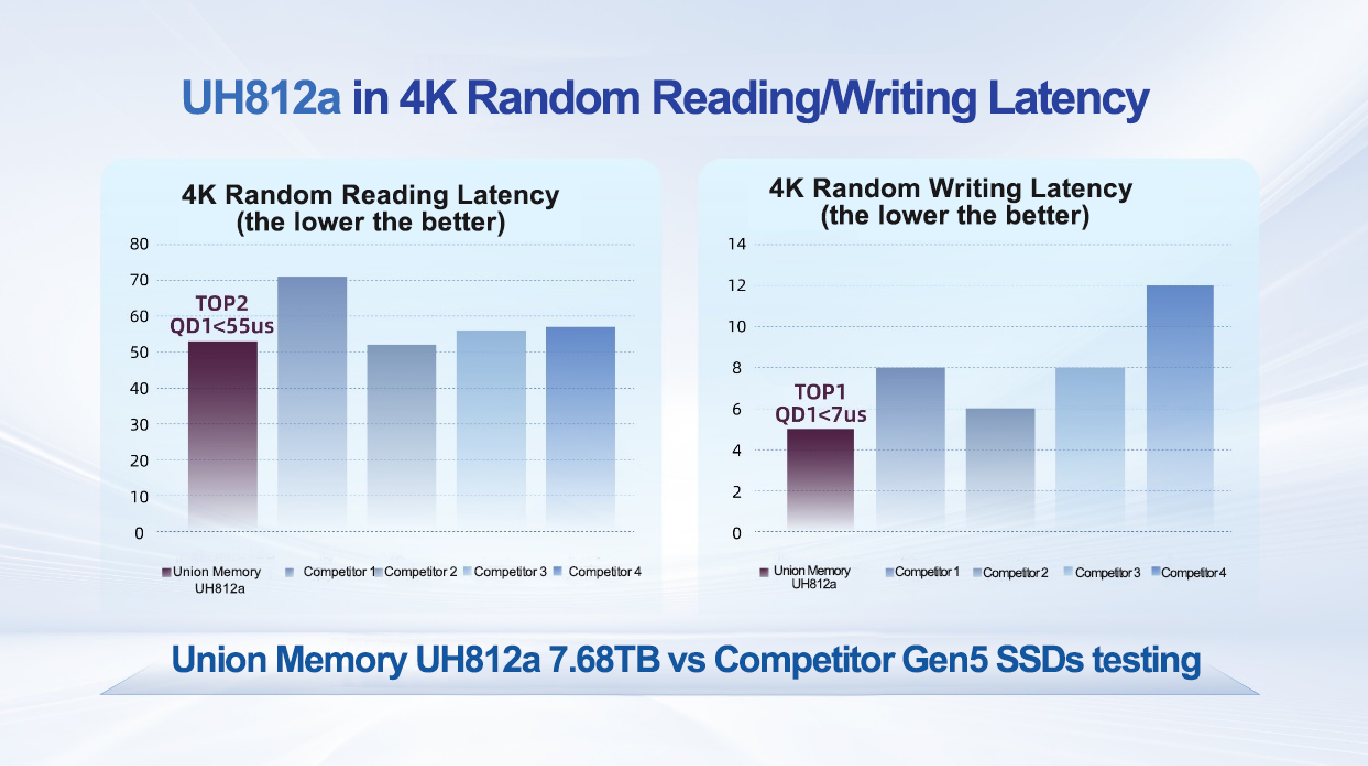
In hyper-scale data centers, the size of data stored grows exponentially, and it could reach the PB-EB level in the future, making the reliability of storage devices particularly crucial.
Strict Testing: Relying on JEDEC standards, Union Memory UH812a/UH832a reliability tests cover a more extensive range and stricter indicators. It is also the first PCIe Gen5 ESSD passing the neutron testing in its industry. Under harsh conditions such as high temperature, high humidity, and neutron irradiation, the test results of Union Memory UH812a/UH832a show its advantages in data security and device stability. Whether it is for the daily operation of data centers or in response to emergencies, it can provide users with reliable data storage services, effectively avoiding data loss and service interruption caused by device failures.
Excellent Algorithm: Based on the industry-leading LDPC algorithm, Union Memory UH812a/UH832a features super error correction capabilities, and it is capable of accurately identifying and correcting the errors that occur during data transmission and storage. In addition, its ultra-low latency decoding capability significantly enhances the information processing rate, ensuring stable performance throughout the entire lifecycle of SSDs. The performance fluctuation within the entire lifecycle is less than 10%, providing a solid storage foundation for the stable and efficient operation of mixed services in data centers, as well as center cloud/edge cloud storage services.
MTBF & AFR of Higher Confidence: With high-frequency sampling throughout the entire lifecycle and combined with the ORT mechanism, the confidence of MTBF (mean time between failures) and AFR (annualized failure rate) are significantly enhanced. After rigorous testing and verification, MTBF is ≥ 250W hours, and AFR is ≤ 0.35%. These key indicators are all at the industry-leading level, providing strong support for the stable and secure operations at the data centers with outstanding data performance.
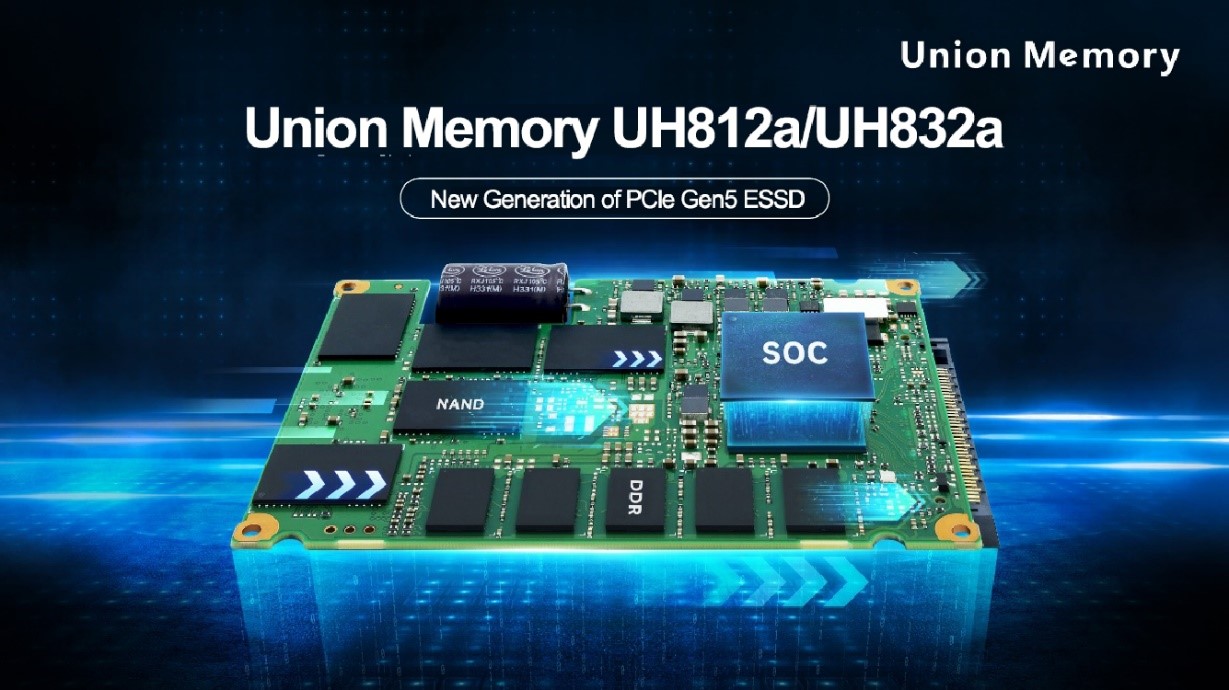

Ø High-precision Voltage Detection and Intelligent Algorithm: Union Memory UH812a/UH832a uses high-precision voltage detection technology, conducting regular background sampling of the operating state of all NAND cells. By leveraging intelligent algorithm and scan results, it can efficiently obtain the optimal threshold voltage for all NAND cells. Even in the event of SSD power failure, it can estimate the power-failure time upon power-on and compensate the activation voltage, ensuring that the SSD controller can accurately read data in any scenario.
Ø High-performance LDPC Algorithm: Union Memory's high-performance LDPC algorithm, through “column weight, Tanner graph, girth cycles, and trapping sets” quadruple optimization, endows LDPC codes with super error correction capabilities and an UBER (uncorrectable bit error rate) of less than 1E-18. After optimization of the high-parallel decoding algorithm, even when the count of errors increases, the decoding success rate and bandwidth can still be guaranteed. Incorporating fine voltage management and LDPC error correction technology, Union Memory UH812a/UH832a can ensure the successful first reading of SSD without significant bandwidth fluctuations.
Ø Innovative Technology in Response to Data Write-in: One challenge for enterprise SSDs lies in handling massive write workloads. With write workloads reaching up to 3DWPD (3 full drive writes per day), the garbage collection mechanism leads to write amplification, which further increases the actual NAND write volume, causing deterioration of NAND cells and subsequently affecting the performance and reliability of the device. Union Memory UH812a/UH832a, on the one hand, increases the overall write endurance through NAND cell health detection, and on the other hand, reduces write amplification through intelligent data identification, improving the health of SDDs. Meanwhile, through health monitoring technology, it can detect deteriorating NAND cells earlier, combined with dynamic wear leveling technology, allowing “robust” NAND to withstand more wear and protecting “weak” NAND, thereby enhancing the overall write endurance of SSDs.
Ø Intelligent Identification and Classification of Cold and Hot Data: In the actual application of SSDs, the written-in data has two types: “cold” data and “hot” data. Union Memory's intelligent identification and classification technology can identify the write hotspots without user input, enabling precise cold/hot data separation and optimized placement. During garbage collection, it can significantly reduce the amount of effective data migration, reduce the write amplification of SSDs, and extend the lifespan of SSDs.
With the advancing process of SSD control chips, the power consumption of servers and the heat dissipation of SSDs have become the key factors affecting server performance, cost, and reliability. To further reduce server power consumption, the control strategies for BMC power consumption are also becoming increasingly demanding.
When the conventional BMC speed control strategy focuses on regulating temperature, Union Memory innovatively incorporates the SSD power consumption detection function, enabling the server BMC to simultaneously monitor temperature and power consumption, thereby establishing a more effective server fan speed regulating strategy.
Union Memory has embedded into the SSD a power consumption detection circuit with a dedicated resistor. During the operation of the server, the 12V voltage passes through the detection resistor and causes a slight voltage drop. Through collection, calculation, and amplification, the power consumption data of the SSD can be accurately calculated. After rigorous verification, the power consumption detection error of Union Memory UH812a/UH832a is ≤ 3%, and it can perform real-time detection by refreshing data every second. The power consumption detection results are stored in Union Memory's custom smart information. Users can directly query and obtain the real-time power consumption information of the SSD through the server's BMC, which is helpful for server heat dissipation management, reducing energy consumption, and thereby improving the overall energy efficiency of the data center.
Leveraging the deep thinking capacity of DeepSeek, we can see the path of storage capacity leapfrogging from excellent performance, stable reliability, to innovative technology, of Union Memory PCIe Gen5 ESSD UH812a/UH832a. With its strong innovation capabilities in the field of ESSDs, Union Memory will continue to drive the evolution of storage technology, providing efficient storage solutions for such scenarios as online core services of enterprises, mixed services at data centers, cloud computing and large models. In the PCIe 5.0 era, we will help users unleash the enterprise-grade intelligent storage capacity.